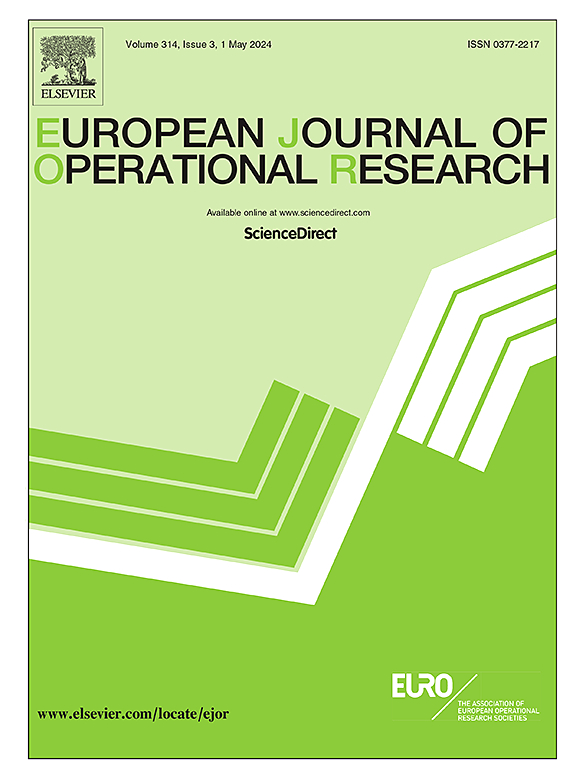Fleet repositioning in the tramp ship routing and scheduling problem with bunker optimization: A matheuristic solution approach
IF 6
2区 管理学
Q1 OPERATIONS RESEARCH & MANAGEMENT SCIENCE
引用次数: 0
Abstract
This paper investigates an important planning problem faced by dry bulk shipping operators, referred to as the Tramp Ship Routing and Scheduling Problem with Bunker Optimization (TSRSPBO). The problem is to maximize the overall profit of a fleet of vessels by selecting cargoes and determining ship routes and schedules. We consider this problem under a set of practically relevant features such as flexibility in cargo quantities, as well as bunkering decisions on where to procure fuel and how much. As a particularly novel feature, we address the regional allocation of vessels at the end of the planning period to be well prepared for meeting (uncertain) future demand. To incorporate this, we consider the TSRSPBO as a two-stage stochastic programming problem, where cargo selection, routing, and bunkering decisions are solved in the first-stage problem, and the recourse cost of fleet repositioning is considered in the second stage. We present arc flow and path flow formulations, where the latter employs a priori generation of feasible routes as input. For solving realistically sized instances, we propose a matheuristic based on an Adaptive Large Neighborhood Search (ALNS) framework that iteratively generates columns and solves the path flow model. Computational experiments based on real data show that this matheuristic finds high-quality solutions for large test instances with 120 cargoes, 30 vessels, and ten bunker ports in less than one hour. Also, considering the TSRSPBO as a two-stage stochastic problem achieves the highest profits and is solved almost as quickly as the deterministic problem variant.
带有燃料优化的杂货船路由和调度问题中的船队重新定位:一种数学启发式求解方法
本文研究了干散货航运运营商面临的一个重要规划问题,即 "干散货船舶航线和船期优化问题(TSRSPBO)"。该问题的目的是通过选择货物、确定船舶航线和船期来实现船队整体利润的最大化。我们在考虑这一问题时,考虑了一系列与实际相关的特征,如货物数量的灵活性,以及在哪里采购燃料和采购多少燃料的加油决策。作为一个特别新颖的特征,我们解决了在计划期结束时的船舶区域分配问题,以便为满足(不确定的)未来需求做好充分准备。为此,我们将 TSRSPBO 视为一个两阶段随机编程问题,在第一阶段问题中解决货物选择、航线安排和加油决策,在第二阶段考虑船队重新定位的追索成本。我们提出了弧流式和路径流式,其中路径流式采用先验生成的可行路线作为输入。为了求解实际大小的实例,我们提出了一种基于自适应大邻域搜索(ALNS)框架的数学启发式,该框架可迭代生成列并求解路径流模型。基于真实数据的计算实验表明,对于包含 120 件货物、30 艘船舶和 10 个加油港的大型测试实例,该有限元法能在一小时内找到高质量的解决方案。此外,将 TSRSPBO 视为两阶段随机问题可获得最高利润,其求解速度几乎与确定性问题变体相同。
本文章由计算机程序翻译,如有差异,请以英文原文为准。
求助全文
约1分钟内获得全文
求助全文
来源期刊

European Journal of Operational Research
管理科学-运筹学与管理科学
CiteScore
11.90
自引率
9.40%
发文量
786
审稿时长
8.2 months
期刊介绍:
The European Journal of Operational Research (EJOR) publishes high quality, original papers that contribute to the methodology of operational research (OR) and to the practice of decision making.
 求助内容:
求助内容: 应助结果提醒方式:
应助结果提醒方式:


